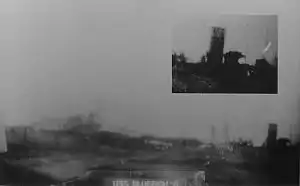Japanese fleet oiler Hayasui
The Hayasui (速吸, "Quick Absorption") was a Japanese fleet oiler (hybrid tanker/carrier) of the Imperial Japanese Navy (IJN), serving during World War II.
 Hayasui sinking on 19 August 1944 | |
| History | |
|---|---|
| Name: | Hayasui |
| Namesake: | Hayasui-no Seto |
| Builder: | Harima Dock Company |
| Laid down: | 1 February 1943 |
| Launched: | 25 December 1943 |
| Completed: | 24 April 1944 |
| Decommissioned: | 10 October 1944 |
| Fate: | Torpedoed and sunk by USS Bluefish, 19 August 1944 |
| General characteristics | |
| Displacement: | 18,300 long tons (18,594 t) standard |
| Length: | 161.00 m (528 ft 3 in) overall |
| Beam: | 20.10 m (65 ft 11 in) |
| Draught: | 8.83 m (29 ft 0 in) |
| Propulsion: |
|
| Speed: | 16.5 knots (19.0 mph; 30.6 km/h) |
| Range: | 9,000 nmi (17,000 km) at 16 kn (18 mph; 30 km/h) |
| Capacity: |
|
| Complement: | 301 |
| Armament: |
|
| Aircraft carried: | 6 + 1 (Aichi E13A or Aichi B7A) |
| Aviation facilities: | catapult and deck |
Construction
Hayasui was completed as one of the Kazahaya class fleet oilers. After lack of reconnaissance planes was identified as a contributing factor to defeat of the IJN at the Battle of Midway, aviation facilities were added to Hayasui for accompanying the carrier task force. The IJN added the function of food supply ship to Hayasui to improve carrier task force endurance following experience at the Battle of the Santa Cruz Islands.
Service
- 24 April 1944 : Completed.
- May 1944 : Sailed to Tawi-Tawi for Operation A.
- 19 to 20 June 1944 : Participation to the Battle of the Philippine Sea and damaged.
- 10 August 1944 : Repairs were completed for convoy Hi-71 departure from Moji to Singapore.
Fate
- 03:20, 19 August 1944 : Hayasui was torpedoed (2 hits) by USS Bluefish at west of Vigan City.
- About 05:00 : Explosion and sunk at 17°34′N 119°24′E.
- 10 October 1944 : Decommissioned.
References
- "Rekishi Gunzō"., History of Pacific War Vol.62 "Ships of The Imperial Japanese Forces, Gakken (Japan), January 2008, ISBN 978-4-05-605008-0
- Ships of the World special issue Vol.47, Auxiliary Vessels of the Imperial Japanese Navy, "Kaijinsha"., (Japan), March 1997
This article is issued from Wikipedia. The text is licensed under Creative Commons - Attribution - Sharealike. Additional terms may apply for the media files.